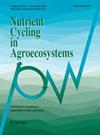甘蔗种植过程中土壤氧化亚氮排放的多试验评价
IF 2.7
3区 农林科学
Q2 SOIL SCIENCE
引用次数: 0
摘要
土壤氧化亚氮(n2o)通量是农产品温室气体排放的重要组成部分,但由于气候、土壤和管理变量之间复杂的相互作用,其在空间和时间上都是可变的。本研究旨在利用田间试验的多站点数据库,确定影响甘蔗氮氧化物排放的主要因素。从2011-2017年期间的13个田间试验中获得了温室气体通量、土壤、气候和管理数据。我们在不同肥料和蒸馏物(酒糟)类型和比例以及作物残留物率的实验中进行了探索性、描述性和推断性数据分析。氮氧通量最高的时期是施肥后的前46天。结果表明,累积氮氧与氮肥施用量、土壤真菌群落(18S rRNA基因)、土壤铵态氮(nh4 +)和硝态氮(no3−)呈极显著正相关;氨氧化古菌(AOA)的amoA基因与土壤有机质含量呈中度负相关。回归分析表明,易于常规测量的气候和管理相关变量解释了50%以上的累积n2o排放变化,并且额外的土壤化学和物理参数改善了回归拟合,r2 = 0.65。交叉小波分析表明,在长达64天的时间内,氮氧通量与降雨量和气温存在显著的相关关系,在一些实验中存在2 ~ 4天的时间滞后,总体上表现出良好的环境控制通量。氮肥的平均排放因子范围为施氮量的0.03 ~ 1.17%,尿素和硝酸铵加酒糟产生高排放,而硫酸铵、不加酒糟的硝酸铵、硝酸钙和缓解替代品(硝化抑制剂和酒糟施用时间)产生低氮肥O-EFs。来自多个地点、跨越多个种植季节的测量结果有助于探索环境和管理相关变量对甘蔗生产过程中土壤氮素排放的影响,为减缓全球变暖战略、氮素管理政策和提高农业投入效率提供支持。本文章由计算机程序翻译,如有差异,请以英文原文为准。
Multi-experiment assessment of soil nitrous oxide emissions in sugarcane
Abstract Soil nitrous oxide (N 2 O) fluxes comprise a significant part of the greenhouse gas emissions of agricultural products but are spatially and temporally variable, due to complex interactions between climate, soil and management variables. This study aimed to identify the main factors that affect N 2 O emissions under sugarcane, using a multi-site database from field experiments. Greenhouse gas fluxes, soil, climate, and management data were obtained from 13 field trials spanning the 2011–2017 period. We conducted exploratory, descriptive and inferential data analyses in experiments with varying fertiliser and stillage (vinasse) type and rate, and crop residue rates. The most relevant period of high N 2 O fluxes was the first 46 days after fertiliser application. The results indicate a strong positive correlation of cumulative N 2 O with nitrogen (N) fertiliser rate, soil fungi community (18S rRNA gene), soil ammonium (NH 4 + ) and nitrate (NO 3 − ); and a moderate negative correlation with amoA genes of ammonia-oxidising archaea (AOA) and soil organic matter content. The regression analysis revealed that easily routinely measured climate and management-related variables explained over 50% of the variation in cumulative N 2 O emissions, and that additional soil chemical and physical parameters improved the regression fit with an R 2 = 0.65. Cross-wavelet analysis indicated significant correlations of N 2 O fluxes with rainfall and air temperature up to 64 days, associated with temporal lags of 2 to 4 days in some experiments, and presenting a good environmental control over fluxes in general. The nitrogen fertiliser mean emission factors ranged from 0.03 to 1.17% of N applied, with urea and ammonium nitrate plus vinasse producing high emissions, while ammonium sulphate, ammonium nitrate without vinasse, calcium nitrate, and mitigation alternatives (nitrification inhibitors and timing of vinasse application) producing low N 2 O-EFs. Measurements from multiple sites spanning several cropping seasons were useful for exploring the influence of environmental and management-related variables on soil N 2 O emissions in sugarcane production, providing support for global warming mitigation strategies, nitrogen management policies, and increased agricultural input efficiency.
求助全文
通过发布文献求助,成功后即可免费获取论文全文。
去求助
来源期刊

Nutrient Cycling in Agroecosystems
农林科学-土壤科学
CiteScore
5.90
自引率
3.20%
发文量
61
审稿时长
4.5 months
期刊介绍:
Nutrient Cycling in Agroecosystems considers manuscripts dealing with all aspects of carbon and nutrient cycling as well as management and examining their effect in ecological, agronomic, environmental and economic terms. Target agroecosystems include field crop, organic agriculture, urban or peri-urban agriculture, horticulture, bioenergy, agroforestry, livestock, pasture, and fallow systems as well as their system components such as plants and the fertility, chemistry, physics or faunal and micro-biology of soils. The scale of observation is the cycles in the soil-plant-animal system on or relevant to a field or watershed level as well as inputs from or losses to the anthroposphere, atmosphere and hydrosphere. Studies should thus consider the wider system in the examination of cycling and fluxes in agroecosystems or their components. These may include typically multi-year field observations, farm gate budgets, watershed studies, life cycle assessments, enterprise and economic analyses, or regional and global modeling. Management objectives may not only include the maximization of food, fiber and fuel production, but also its environmental and economic impact. The results must allow mechanistic conclusions of broad applicability and distinguish itself from empirical results or case studies of merely local or regional importance. If unsure whether a study fits into this scope, please contact the editor with a brief inquiry before manuscript submission.
 求助内容:
求助内容: 应助结果提醒方式:
应助结果提醒方式:


